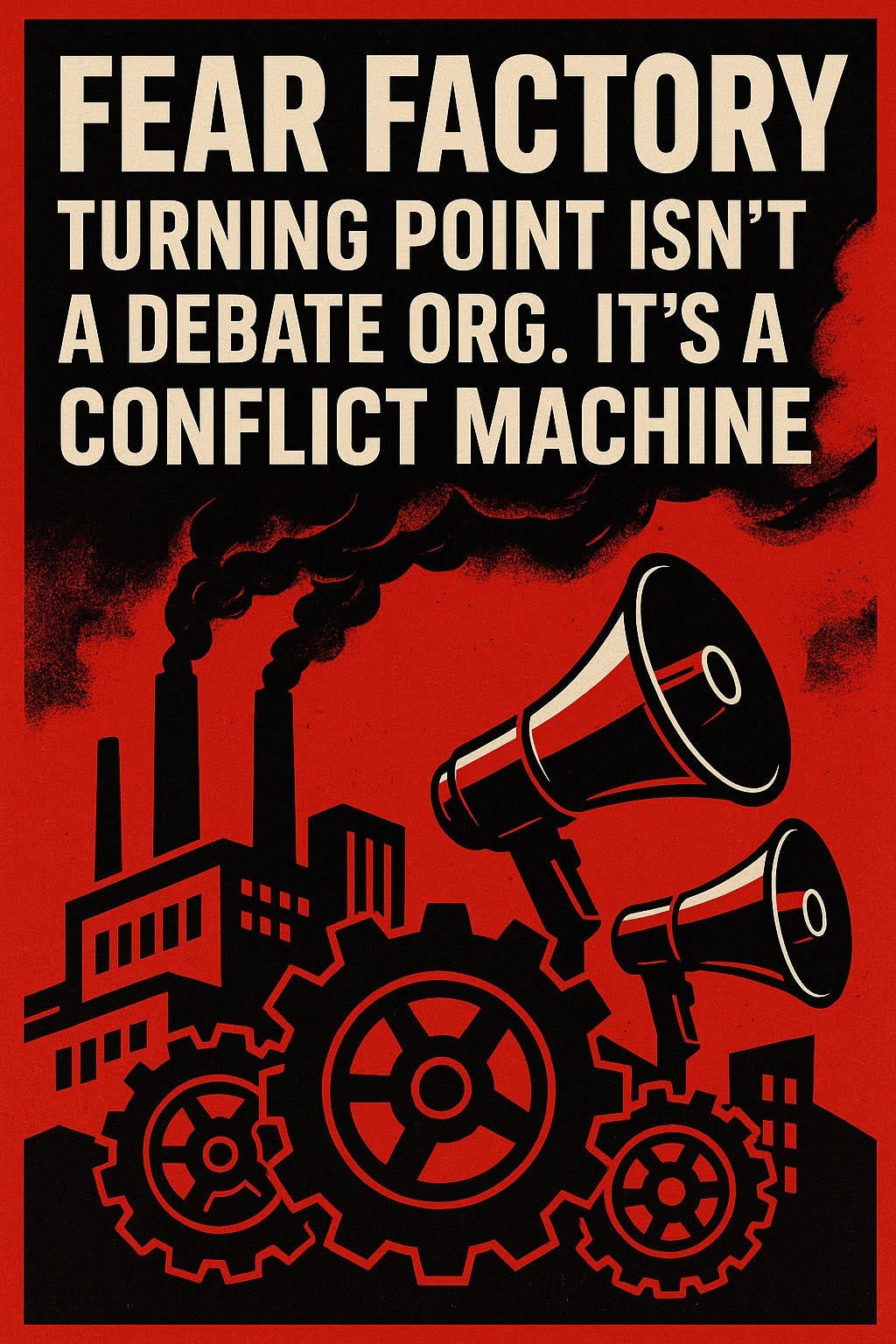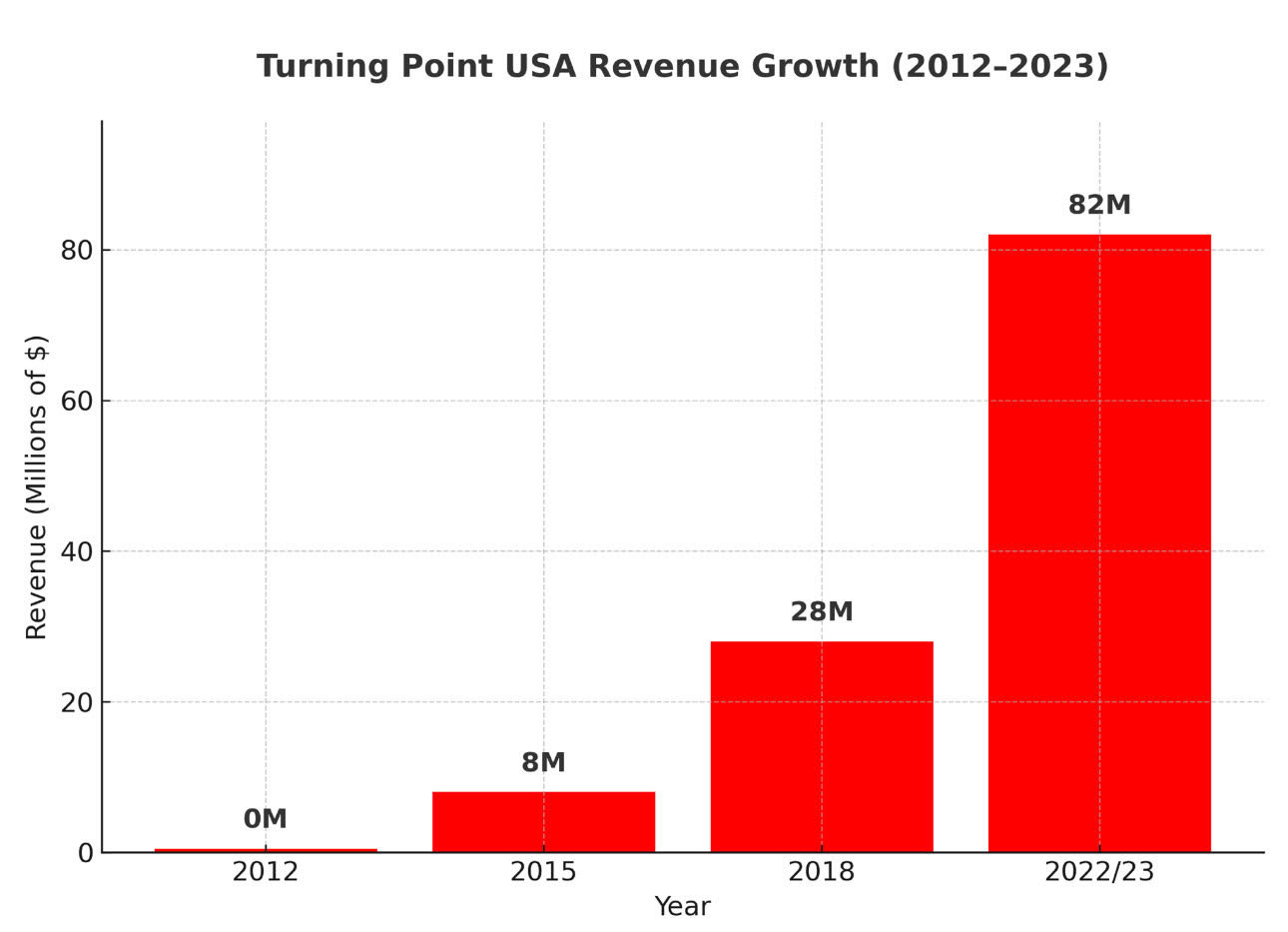Fear Factory
Turning Point isn't a Debate Organization, its a Conflict Machine
Charlie Kirk didn’t invent conflict entrepreneurship, but he sure helped to perfect it. He is the prototype of a generation of right wing internet entrepreneurs who figured out that the surest way to build power, attention, and money otherwise off limits to them is not by governing, legislating, or even persuading—it’s by manufacturing outrage and monetizing it.
From the garage to the donor class
Kirk founded Turning Point USA in 2012 at just 18 years old but he wasn’t some grassroots kid hustling alone. He had a mentor, Tea Party activist Bill Montgomery, and very quickly he had a benefactor: Foster Friess, a conservative megadonor who bankrolled much of the group’s early work. That early money mattered. It allowed TPUSA to scale fast—staff, merch, events, and a social media strategy that turned “triggering the libs” into a donor-driven business model.
By 2015, Kirk had what every young conservative hustler of the early digital age wanted: legitimacy with the Republican elite. He was on panels, quoted in political press, and standing on the floor of the Republican National Convention in 2016 being profiled as the future of conservatism.
Socialism Sucks
But what really launched him was the backlash to Bernie Sanders. Sanders’ run in 2016 mainstreamed the word “socialism” for the first time in decades, and Kirk saw a marketing opportunity. Turning Point flooded campuses with “Socialism Sucks” and “Big Government Sucks” t-shirts, table tents, and memes.
It was a masterstroke: simple, viral, and conflict-first. The shirts weren’t just merch; they were props for confrontation. Put one on, walk into a campus dominated by liberal students and professors, and you had a fight on your hands. That fight turned into content, which turned into clips, which turned into fundraising emails.
Kirk wasn’t trying to win the debate on socialism. He was trying to win the algorithm. And he did.
The Professor Watchlist
The first time I heard of Charlie Kirk was when someone told me to be careful about ending up on his watchlist.
In 2016, TPUSA launched the Professor Watchlist, naming academics it claimed “discriminated” against conservative students. The watchlist was perfect fear-grift engineering: frame conservatives as victims, pick a fight with institutions the right already hated, and let the outrage do the work.
Universities condemned it, professors protested, the media covered it—and every bit of that coverage made Kirk stronger. To his base, outrage proved TPUSA was effective. To donors, it proved Kirk could draw fire, which is the most valuable commodity in the right-wing economy.
Note: these people came after me once but backed off once I started referring them to all the young conservatives I had mentored on two conservative-leaning campuses over my career.
Scaling the Fear Factory
By the late 2010s, TPUSA was not a student group—it was a nonprofit empire. Annual revenues soared into the tens of millions. By 2022, filings showed roughly $80 million a year flowing through the organization. That money built Kirk’s ecosystem:
Events: giant rallies like Student Action Summit and AmericaFest, featuring Fox stars and MAGA influencers.
Merch and memes: endlessly recycling “Socialism Sucks” and other slogans into content verticals.
Media: Kirk’s podcast and radio show, one of the top conservative podcasts by 2020.
These weren’t silos; they were a machine. Each event fed social clips. Each clip fed donors. Each donor kept the events growing. It was a perpetual motion machine of outrage.
Spinning into politics
Kirk understood that to stay relevant he needed more than clout—he needed power. In 2019 he launched Turning Point Action, a 501(c)(4) political arm. Almost immediately, TPAction absorbed Students for Trump, giving him direct access to Trump’s youth mobilization.
By 2024, TPAction was running ground operations like “Chase the Vote,” openly integrated into the Trump campaign’s turnout program. Kirk had built the bridge every grifter dreams of: a pipeline from memes to votes, from clout to campaigns.
January 6
On January 5th, Kirk tweeted proudly that TPUSA was sending “over 80 buses” of students to Washington. After the violence, he deleted it and TPUSA claimed it was only seven buses. But the damage was done. The deleted tweet tied his organization directly to Stop the Steal.
It didn’t matter that he tried to backpedal. By then, Kirk was fully in the MAGA bloodstream. He was no longer just a campus agitator; he was an operator in the broader Trumpist movement.
Adding God to the mix
After 2021, Kirk launched TPUSA Faith, an explicit effort to take the same conflict-driven model into churches. This was smart scaling. Kirk had already perfected his schtick for college campuses. Evangelical churches were a much bigger pool of grievance and money.
TPUSA Faith didn’t hide its goal: fuse Christian identity with MAGA politics. That put Kirk at the center of the Christian nationalist surge inside the Republican Party. It also insulated him against future campus pushback; if universities banned TPUSA, churches would always be open.
The business model of fear
Kirk’s success wasn’t an accident. It was a formula:
Pick a villain. Professors, liberals, socialists, the media.
Package it simply. “Socialism Sucks” is not an argument, it’s a brand.
Create conflict. Force confrontation to generate attention.
Monetize the outrage. Events, merch, donations, podcasts.
Expand the TAM. From campuses to churches to elections.
It is conflict as product. Outrage as distribution. Fear as revenue stream.
I can barely pay my bills (thank you paid subscribers!) but I could be rich tomorrow if I decided to become a MAGA grifter and tell Americans big lies for big money.
The Fear-Grifter archetype
Kirk represents the first full generation of what I call fear-grifters: political entrepreneurs whose actual product is fear, not policy. They thrive on chaos. They profit from division. They scale not by convincing people but by enraging them.
For Kirk, every confrontation was a win. If a professor condemned him, if a journalist fact-checked him, if a liberal student shouted him down, it wasn’t failure—it was marketing. And the more enemies he could claim, the more indispensable he looked to the conservative movement.
Legacy
By 2025, Kirk was no longer just a kid with a donor-funded nonprofit. He was running a multi-arm enterprise with media, political, and religious wings. He had transformed himself into a hub of MAGA youth culture and a conduit between billionaire donors and grassroots activists.
The irony is that Kirk himself was never especially ideological. He didn’t have the intellectual rigor of a William F. Buckley or even the crude charisma of a Trump. What he had was instinct. He understood that in the modern right-wing economy, conflict is the only currency that matters.
And he spent a decade printing it.
In his wake, Turning Point and Charlie Kirk will only become stronger. Kirk’s assassin may have thought he was killing fascism, but what he was really doing was rolling out a red carpet for it.
We will all be left to deal with its aftermath.






Who, if anyone, is doing this kind of organizing for the liberal / progressive / Democrat / leftist / whatever you want to call them youth? I'm not seeing any media coverage of an anti-Trump youth movement. From my limited vantage point as a retiree in white purple suburbia, I'm not seeing it. I feel like a massive pro-democracy youth uprising is sorely lacking and needed, but what do I know? Doesn't mean it doesn't exist, but, does it exist?
And there are plenty of Americans that are fed up with any person or group or people with lots of money in America continuing to jam down their throats the way we are supposed to live and be..........and using people's hopes and needs and concerns to manipulate them........to their ends and not what actually helps people lead better lives......